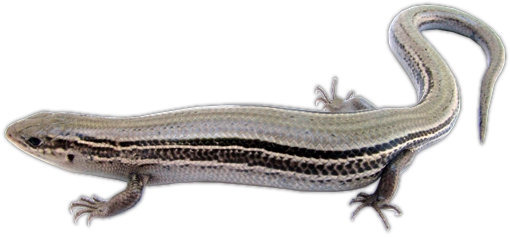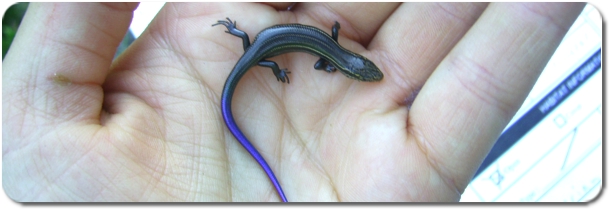Northern Prairie Skink

What it looks like
The Northern Prairie Skink is a small lizard. They are about 20 cm long from nose to tip of the tail. The tail is about half of that length. Adults are gray to olive brown in colour with darker stripes along their sides. In the spring breeding season the males have bright orange patches under the jaw.
Look-alikes
There are no other lizards in Manitoba. A small snake moving through the grass might look like a Northern Prairie Skink, but none of Manitoba's snakes are the same colour as our lizard. A salamander might look like a lizard, but it will have soft skin with no scales and none are the colour of a Northern Prairie Skink.
Name
Skink is the name given to one group of lizards. Northern Prairie Skinks live in the northern part of the prairies of North America. Another kind, the Southern Prairie Skink, lives in the southern regions.
Scientific Name
The Northern Prairie Skink's scientific name is Plestiodon septentrionalis septentrionalis. Learn what that means on this page: Scientific Names.
Where it lives
Northern Prairie Skinks live in the grasslands or prairies of central North America. In Manitoba they are only found in two areas of sand hills in the southwest of the province. They live around the Carberry Sand Hills and the Lauder Sand Hills.
Where Northern Prairie Skinks live in North America.
Habits
Northern Prairie Skinks are active during the day, but spend most of their time under cover. They hide under thickets of grass or juniper branches, or under debris left by people such as boards or cardboard. Skinks are active from May until October in Manitoba. They burrow deep into sandy soils to spend winter below the frost line.
Food Web
Grasshoppers, crickets and spiders are the main food of these lizards.
Birds such as hawks and crows will eat Northern Prairie Skinks. Western Hognose Snakes will eat skinks, too. Large frogs and toads could eat the young lizards.
Life Cycle
Northern Prairie Skinks breed in spring, usually in May. Females lay 10 - 12 eggs in a shallow nest, usually under some sort of object. They hatch after about 50 days, usually in August. The young are about 4 - 5 cm at birth and take 2 years to reach adult size. They can live for about 5 to 7 years.

Hatchling Northern Prairie Skinks have bright blue tails.
(Photo: Pamela Rutherford)
Numbers
These lizards are rare in Manitoba because they can only live in certain sandhill areas. In their habitat there might be lots of skinks around, maybe as many as 50 per hectare.
Special Things
The Northern Prairie Skink is the only lizard tough enough to live in southern Manitoba. It is rare here because it needs open, grassy sandhills as habitat and these are uncommon in our province. Manitoba is the only place in Canada where they live. They are an Endangered Species that need our protection.
How to Find Northern Prairie Skinks
In the sandhill areas where they live you can sometimes see them on trails on sunny days. It is quite rare to see one though.
Use by People
Northeren Prairie Skinks aren't used by people. They should not be disturbed in the wild as they are a protected Endangered Species!
| Go back to: Amphibians and Reptiles Front Page |
For more on the Northern Prairie Skink in NatureNorth.com follow these links:
Save Our Skinks | The Northern Prairie Skink
